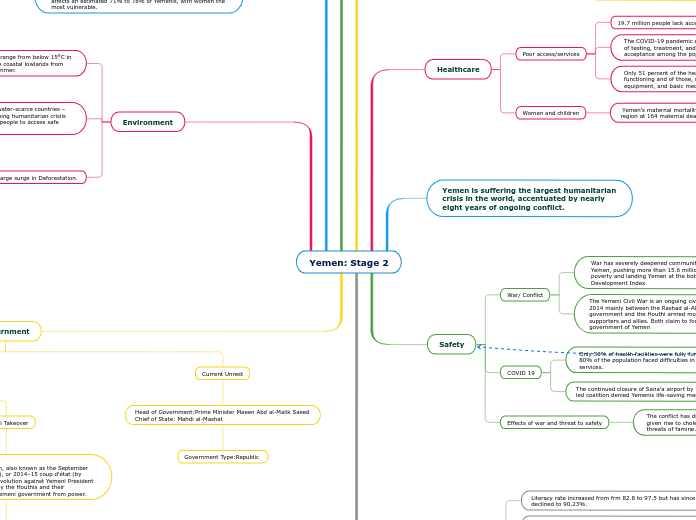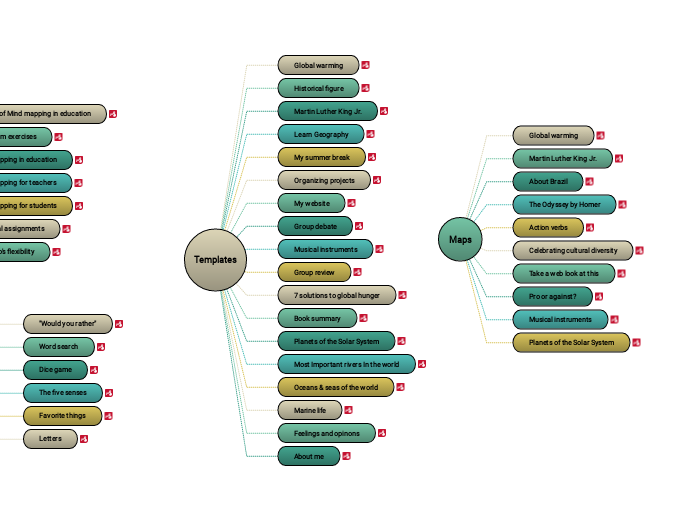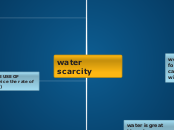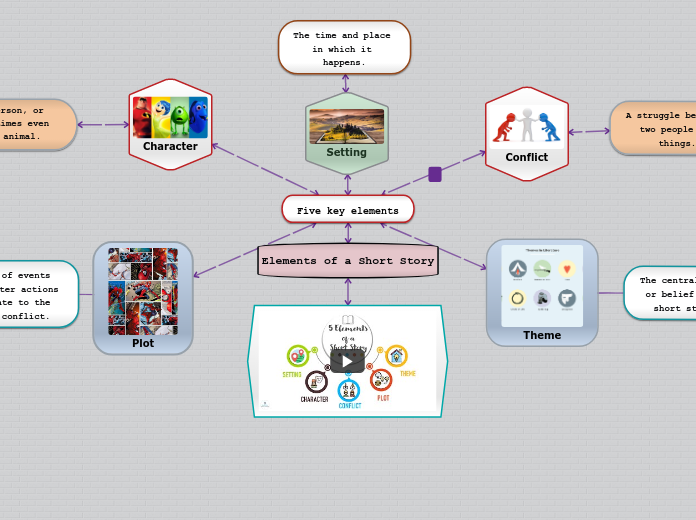Yemen: Stage 2
Government
Current Unrest
Head of Government:Prime Minister Maeen Abd al-Malik Saeed Chief of State: Mahdi al-Mashat
Government Type:Republic
History
Houthi Takeover
The Houthi takeover in Yemen, also known as the September 21 Revolution (by supporters), or 2014–15 coup d'état (by opponents), was a popular revolution against Yemeni President Abdrabbuh Mansur Hadi led by the Houthis and their supporters that pushed the Yemeni government from power.
Constitution: Adopted: 1991; Defines the republic as independent, sovereign, Arab, and an Islamic country. Also establishes sharia, or Islamic law, as the basis of all laws.
Government forces fighting the Houthis created the
civil war still active today.
Environment
Experiencing a large surge in Deforestation.
The increasing demand for wood has prompted a wave of deforestation, the effects of which are likely to be devastating to Yemen's long-term development.
Severe fuel shortages resulting from a blockade of Houthi-controlled areas and restrictions on imports into Al Hodeidah port have forced people and businesses to chop down trees for firewood
It is already one of the world's most water-scarce countries – and desertification as well as the ongoing humanitarian crisiis making it much harder for millions of people to access safe drinking water
About 18 million people lack access to safe water and sanitation
Due to
a lack of law enforcement to regulate water use
high population growth,
misguided agricultural development and policies
high vulnerability to climate change.
Mean temperatures in the highlands range from below 15°C in winter to 25°C in summer, and in the coastal lowlands from 22.5°C in winter to up to 35°C in summer.
Economy
Numbers
More than 40% of Yemeni households that find it difficult to buy even the minimum amount of food may have also lost their primary source of income.
Poverty was worsening even before the crisis, affecting almost half of Yemen’s total population of about 29 million. Now it affects an estimated 71% to 78% of Yemenis, with women the most vulnerable.
The economy of Yemen is one of the poorest and least-developed in the world.
Why so poor?
Yemen has long been the poorest country in the Middle East and North Africa. It is now in the midst of one of the world's worst humanitarian crises. The fighting that has been raging since early 2015 has devastated its economy, leading to severe food insecurity and destroying critical infrastructure.
Millions of civilians in Yemen depend on humanitarian aid.
Because of their livliehoods being destroyed by the war
they have lost all sources of income and are unable to support themselves or their families.
Timeline
April 2022 – The UN brokered a two-month truce between warring parties that is to begin with the holy month of Ramadan. The agreement is a notable step toward peace, as the last nationwide coordinated cessation of hostilities was during peace talks in 2016.
Despite the two-month truce, Houthi forces resume attacks on the front lines of the battle for Marib which have been static since February, when UAE backed forces pushed Houthis out of the center of the Hareb district.
Houthi rebels sign an “action plan” to prevent the recruitment and use of children in armed conflict. A senior Houthi military official had said in 2018 that the group inducted 18,000 child soldiers into its army, some of whom as young as 10 years old.
August 2021- The UN outgoing special envoy for Yemen announces nearly 20 million people, or two-thirds of the country’s population, are dependent on humanitarian aid for daily needs.
December 2021 – Due to falling international funding, the World Food Program (WFP) cuts food aid to Yemen. In November 2021, WFP targeted 11.1 million for food assistance. The cost of food dramatically increases as the humanitarian situation deteriorates.
February 2022- On February 23, the US Treasury Department announces new sanctions against individuals involved in a funding network for the Houthis.
The United Nations Security Council renews for one year its arms embargo on Yemen, and continues a travel ban and asset freeze on actors who threaten the peace.
March 2022- The World Food Program declares that the humanitarian situation in Yemen is worsening because of the Russian war on Ukraine.
Houthis continue attacks against Saudi oil facilities, while the coalition continues its strikes against Sanaa and Hodeida.
January-February 2020 – Fighting between the Saudi-led coalition and the Houthis picks up. Houthi forces carry out missile attacks on military training camps and in Saudi Arabia’s southern provinces.
March 2020- The Trump Administration announces a freeze on $73 million in humanitarian aid to Yemen, fearing the Houthi rebels would control the assistance.
March 2021- The fighting coincides with ongoing Houthi missile and drone attacks against Saudi oil facilities, airports, and airbases. Saudi Arabia retaliates with airstrikes, particularly in Sanaa. The US condemns Houthi actions. Riyadh proposes a ceasefire, which includes reopening of Hodeida seaport and Sanaa airport. Houthis reject the proposal
December 2018: In December 2018, the US Senate, for the first time, votes to invoke the War Powers Resolution to force the US military to end its participation in the Yemen war.
January-June 2019 – Fighting continues. Houthis launch a drone attack on Al-Anad Air Base north of Aden, injuring dozens and killing the head of Yemeni intelligence. By June, the UAE unilaterally scales back its military presence in Yemen while continuing to support the Southern Transition Council.
November 2019 – In an effort to end the fighting between ostensible coalition partners in southern Yemen, Saudi Arabia and the UAE broker a power-sharing agreement between their respective partners in the Yemen government forces and the STC. The Riyadh Agreement is signed in early November, but by December, clashes between the two resum
May-November 2017 – Humanitarian agencies and watchdogs decry the Yemen crisis as one of the worst humanitarian emergencies in the world. There are thousands of civilians dead and wounded, an outbreak of cholera, and a potential famine that would leave thousands on the brink of starvation.
March-May 2018 – Fighting escalates along Yemen’s western coast and dozens are killed in Saudi air strikes and security raids. A Saudi-led coalition drone strike kills Saleh Ali al-Sammad, president of Yemen’s Supreme Political Council.
August-October 2018 UN efforts to mediate between the Yemeni government and the Houthi rebels in Geneva, Switzerland are fruitless.
After repeated pleas from Hadi, a Saudi-led coalition of Arab states—including the United Arab Emirates, Egypt, Morocco, Jordan, Bahrain, Sudan, and Kuwait. The coalition launches air strikes against Houthi targets, deploys small ground forces, and imposes a naval blockade. The United States announces its intention to aid the coalition’s efforts.
April 2016 – The United Nations sponsors talks between the Hadi government and the coalition of Houthis and former President Saleh’s General People’s Cong
October 2016-May 2017 – Both sides of the conflict allegedly break ceasefires. The United Nations and others try to broker peace talks and political resolutions. The Houthis claim responsibility for firing missiles into Saudi Arabia, including at the capital, Riyadh.
January 2015 – After being placed under house arrest by the Houthis, Hadi resigns as president.
February 2015 – The Houthis take control of the Yemeni government, a move swiftly denounced by the United Nations. President Hadi flees the presidential palace in Sanaa and escapes to Aden, where he later rescinds his resignation, declaring himself the legitimate president, and deems the Houthi takeover a “coup.”
March 2015 – The Islamic State claims its first major attacks in Yemen, setting off two suicide bombs at Shia mosques in Sanaa. Shortly thereafter, the Houthis seize parts of Taiz.
January 2014 – The National Dialogue Conference concludes after ten months of deliberations, agreeing to a document on which the new constitution would be based.
August 2014 – Following two weeks of anti-government protests, President Hadi dissolves his cabinet and overturns a controversial rise in fuel prices.
September-October 2014 – The Houthis take control over most of Yemen’s capital, Sanaa. The following month the rebels seize the Red Sea port city of Hodeida.
June 2011 – Saleh is seriously injured in a bombing and travels to Saudi Arabia for medical treatment.
November 2011- Saleh signs a deal that has his deputy, Abdrabbuh Mansour Hadi, assume power and form a unity government.
February 2012 – Hadi is sworn in for a two-year term as president after an election in which he stood unopposed.
2009-2010: Operation Scorched Earth – In August 2009, the Yemeni military launches Operation Scorched Earth to crush the Houthi rebellion in Saada. At this point, Houthi rebels begin fighting with Saudi forces in cross-border clashes. Fighting continues until, after rounds of offers and counteroffers, Saleh’s government agrees to a ceasefire with Abdul-Malik al-Houthi and the rebels in February 2010
January 2011 – Demonstrations calling for the end of Saleh’s 33-year rule begin.
January-June 2007 – Early in 2007, the Houthi rebels and Saleh’s government again find themselves at odds. Fighting continues for five months until Abdul-Malik al-Houthi reaches a ceasefire agreement with Saleh with the help of Qatar.
April-July 2008 – The ceasefire had not turned a year-old when more fighting breaks out between the government and the rebels. By July, Ali Abdullah Saleh declares an end to the fighting in the Houthi-dominated Saada governorate.
June-September 2004 – Starting in June 2004, Saleh’s government begins arresting hundreds of Houthi members and issues a reward for Hussein Badreddin al-Houthi’s arrest. Fighting continues until al-Houthi is killed in September.
2005-2006 – clashes between the government and the Houthis continue, but in March 2006, Saleh grants amnesty to 600 Houthi fighters. Saleh goes on to win the 2006 election.
1990’s – After the reunification of Yemen, Ali Abdullah Saleh becomes the president of the Republic of Yemen. At the same time, the Zaidi-Shia group Ansar Allah—or the Houthis—gradually gain power; the group’s rise has the tacit support of President Saleh.
1994: Civil War- after the reunification of Yemen, the unintegrated armies of the north and the south face off, resulting in a brief civil war that resulted in the defeat of the southern army
2000 – Saleh reaches a border demarcation agreement with Saudi Arabia (Treaty of Jeddah) and seeks to disarm the Houthis
Education
Processs
The Basic Education is free and open to all 6-14 years of age
Nine years of primary education, followed by three years of study at secondary level
Crisis
This puts about four million additional children at risk of dropping out or dropping out of school as unpaid teachers leave teaching to find other ways to support their families.
War disrupting learning and education
more than 170,000 teachers in total have not received regular salaries for more than four years due to conflict and geopolitical divisions
Boys and girls are more likely to be forced into child labor or recruited into combat
Girls are forced into early marriage, leaving them trapped in a downward spiral of poverty and unfulfilled potential.
More than 3,600 children have been recruited in Yemen in the past six years.
Progress
In recent years the Government has instated a school feeding program. This program aims to feed children from poor families.
IN the pre-war era of 1999-2013, the enrolment rate increased from 71.3% to 97.5%
Literacy rate increased from frm 82.8 to 97.5 but has since declined to 90.23%.
Safety
Effects of war and threat to safety
The conflict has displaced more than four million people and given rise to cholera outbreaks, medicine shortages, and threats of famine. As well as thousands of deaths.
COVID 19
The continued closure of Sana’a airport by the Saudi Arabia-led coalition denied Yemenis life-saving medical treatment.
Only 50% of health facilities were fully functional and over 80% of the population faced difficulties in accessing healthcare services.
Huthi authorities publicly denied the existence of Covid-19 and spread disinformation about its seriousness. They refused to carry out vaccinations and rejected COVAX-initiative vaccines allocated to them by the government.
War/ Conflict
The Yemeni Civil War is an ongoing civil war that began in late 2014 mainly between the Rashad al-Alimi-led Yemeni government and the Houthi armed movement, along with their supporters and allies. Both claim to form the official government of Yemen
War has severely deepened community vulnerabilities in Yemen, pushing more than 15.6 million people into extreme poverty and landing Yemen at the bottom of the Human Development Index
Yemen is suffering the largest humanitarian crisis in the world, accentuated by nearly eight years of ongoing conflict.
Healthcare
Women and children
Yemen’s maternal mortality ratio is one of the highest in the region at 164 maternal deaths per 100,000 live births.
Among children, the under-5 mortality rate is 59.6 deaths per 1,000 live births, and infant mortality rate is 45.7 deaths per 1,000 live birth
Poor access/services
Only 51 percent of the health facilities in Yemen are fully functioning and of those, most lack operational specialists, equipment, and basic medicines.
These gaps impact services for the most vulnerable, especially women and children.
The COVID-19 pandemic exacerbated these issues with a lack of testing, treatment, and reporting capacity and low vaccine acceptance among the population.
19.7 million people lack access to basic health services
Human Rights
Effects
The International Committee of the Red Cross (ICRC) reported in October 2019 that 50 percent of Yemeni children are experiencing irreversible stunted growth.
War Crimes
As of March, the Saudi-led coalition had conducted between 20,624 and 58,487 airstrikes since March 2015, according to the Yemen Data Project.
Houthi forces, the Yemeni government, the UAE, Saudi Arabia, and various UAE and Saudi-backed Yemeni armed groups have arbitrarily arrested, detained, abducted, or forcibly disappeared people, including children, and tortured or otherwise ill-treated detainees.
Both groups have recruited children as soldiers. Some Yemeni boys were sent to Saudi Arabia for military training, then deployed back to Yemen to fight against Houthi forces.
Almost a third of all airstrikes carried out by the coalition hit civilian objects such as residential homes, hospitals, schools, weddings, farms, food stores, school buses, markets, mosques, bridges, civilian factories, detention centers, and water wells
Add text
Freedom of expression and assembly
peaceful protests were staged against the government and STC in Aden, Ta’iz and southern governments, demanding they address the economic crisis and deteriorating living conditions
According to Mwatana for Human Rights, the government and STC violently repressed these protests, including with gunfire and grenades.









